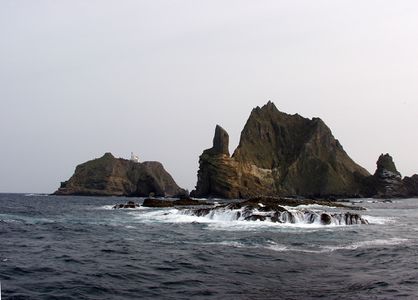"About Dokdo Island"의 두 판 사이의 차이
| 5번째 줄: | 5번째 줄: | ||
=='''About Dokdo Island'''== | =='''About Dokdo Island'''== | ||
<gallery mode=packed heights=200px> | <gallery mode=packed heights=200px> | ||
| − | 파일:2-12.독도1 Dokdo Island.jpg| | + | 파일:2-12.독도1 Dokdo Island.jpg|Dokdo Island / Photo courtesy of the Korea Tourism Organization (Kim Ji-ho) |
| − | 파일:2-12.독도2 Dokdo.jpg| | + | 파일:2-12.독도2 Dokdo.jpg|Dokdo Island / Photo courtesy of the Korea Tourism Organization (Kim Ji-ho) |
| − | 파일:2-12.독도 표지석 Dokdo Island.jpg| | + | 파일:2-12.독도 표지석 Dokdo Island.jpg|Dokdo Sign / Photo courtesy of the Korea Tourism Organization (Kim Ji-ho) |
</gallery> | </gallery> | ||
Dokdo is a group of islets that represent the easternmost point of the Republic of Korea, consisting of two main islets and 89 smaller rocks. Resting way out in the ocean east of the major populated island Ulleungdo, and closer to Ulleungdo than any other nation's territory, it has been designated a Natural Monument for protection of its beauty. | Dokdo is a group of islets that represent the easternmost point of the Republic of Korea, consisting of two main islets and 89 smaller rocks. Resting way out in the ocean east of the major populated island Ulleungdo, and closer to Ulleungdo than any other nation's territory, it has been designated a Natural Monument for protection of its beauty. | ||
2017년 11월 21일 (화) 10:17 판
About Dokdo Island
Dokdo is a group of islets that represent the easternmost point of the Republic of Korea, consisting of two main islets and 89 smaller rocks. Resting way out in the ocean east of the major populated island Ulleungdo, and closer to Ulleungdo than any other nation's territory, it has been designated a Natural Monument for protection of its beauty.
While Japan contests Korea's sovereignty over Dokdo, historical records show that the islets have been under Korean rule since at least the Three Kingdoms period. History of the Three Kingdoms mentions Usando, an ancient island east of Ulleungdo, which is interpreted by experts as a reference to Dokdo. The geography section of Annals of King Sejong from the Joseon dynasty (1392-1910) includes a map that clearly marks both Ulleungdo as Joseon territory.
In the late 17th century Japan officially stated that Dokdo was not Japanese territory. In 1693, a Joseon fisherman named An Yong-bok was fishing in the waters of Ulleungdo when a dispute occurred with Japanese fishermen and he was forcibly taken to Japan. An inquiry into the incident followed and the Edo government ended up confirming that Ulleungdo did not belong to Japan.
Moreover, during the Meiji period, when a survey of Japanese national territory was carried out, the Japanese government again confirmed through the Daijokan Order of 1877 that Japan had nothing to do with Ulleungdo and Dokdo.
Japan began to take serious interest in Dokdo around 1904 when it was waging war with Russia. Realizing the strategic importance of Dokdo, in 1905 Japan made moves to incorporate Dokdo into its territory with a view to installing military facilities there. Korea protested, but it had been robbed of its diplomatic rights by the forced Eulsa Treaty with Japan and there was little the country could do at the time. Koreans see Japan's claim to Dokdo at that time as the start of Japan's imperial aggression.
Dokdo is called Takeshima by the contemporary Japanese, who say that Korea is currently occupying the islets illegally. Japan does not recognize either the Japanese or Korean documentary evidence stating that Dokdo is Korean territory. Today, Dokdo continues to remain peaceful under territorial control of Korea, although Japan tries to make it appear a point of contention between the two countries.
References


